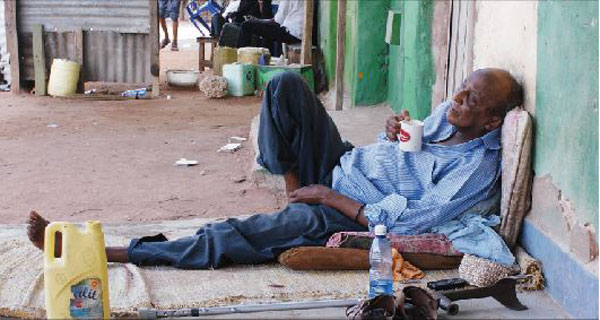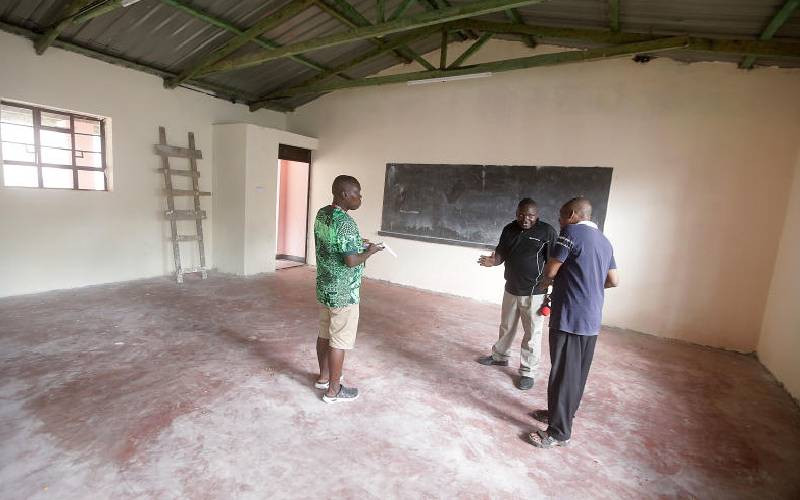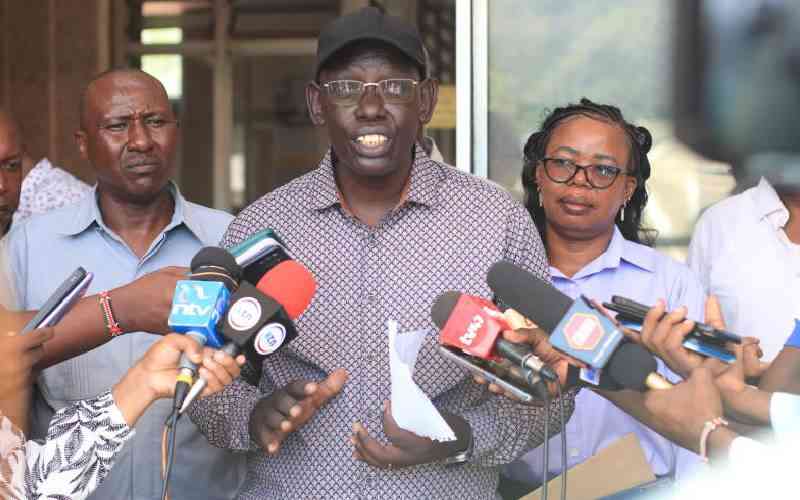 |
|
Mr Abdi Adow, 59, who suffers from severe spinal injury, has not received his Sh2,000 monthly stipend for the last six months from the Government’s cash transfer programme for people living with disabilities. [PHOTO: Paul Wafula/Standard] |
By PAUL WAFULA
Kenya: The Government’s fund for the poor and vulnerable has lost about Sh600 million to ghost recipients in the last five years.
The fund, which has been allocated Sh12.5 billion in the current financial year, has been losing Sh120 million annually meant for the poor, Labour Cabinet Secretary Kazungu Kambi has said.
Mr Kambi said an ongoing audit started late last year on the national safety net fund has already flushed out 1,400 ghost beneficiaries from the disability component of the fund.
“We have already struck off 1,400 ghost recipients from the disability fund and the vetting is ongoing to cover the rest of the programmes, including orphans and vulnerable children,” he said. Mr Kambi told The Standard yesterday that his ministry had established vetting committees that are interviewing recipients in the counties “to ensure that only those who merit under the set criteria remain on the programme”.
This comes a day after The Standard ran a data-driven investigative series on how inclusion and exclusion errors are robbing Kenya’s neediest population money meant to alleviate their suffering.
Started on a pilot basis in 2004 as a donor-funded initiative for orphans and vulnerable children, the programme was upgraded in 2007 when the Government took it over and expanded it to cover the elderly and people living with disabilities.
Last year, the Jubilee administration doubled the number of beneficiaries from 226,839 to 444,096 households. The Sh12.5 billion is scheduled to be disbursed from this month, through the post office network, to support a scale-up to all the 290 constituencies.
Also, the programme this year got a Sh21.5 billion ($ 250 million) boost from the World Bank to be distributed over the next four years.
“Disbursements will only be done directly to the National Treasury upon achievements of agreed targets,” Kambi said. The fund, known as Cash Transfer Programme, gives a Sh2,000 monthly stipend to people living with severe disabilities, the elderly, orphans and vulnerable children to meet their food and healthcare needs. Kambi said to improve the administration of the programme and to seal loopholes that he blamed for the loss of cash, his ministry had established three levels of co-ordination and implementation to ensure effective cash transfers.
He said he had appointed a ministerial social assistance steering committee at the national level and set up an administrative structure for co-ordination comprising the County Social Office and County Children’s officers at the county level.
Validation exercises
In addition, a 17-member committee to be presided over by the area MP will be formed at the constituency level.
“The role of this committee will be to ensure that the targeting of the beneficiaries is done in accordance with the eligibility criteria to ensure transparency and accountability. This is further enhanced through community validation exercises for all the potential beneficiaries,” Mr Kambi said.
The ministry invited the Parliamentary Committee on Labour and Social Welfare to Mombasa last November to discuss and agree on a way forward for the national roll out of the scaled up programme.
Stay informed. Subscribe to our newsletter
Kambi explained that at the end of the deliberations, the ministry and the parliamentary committee resolved that the targeting and scale-up during this financial year be based on a 30:70 ratio where 30 per cent of the funds shall be shared equally to all 290 constituencies and 70 per cent shall be equitably distributed — to enable constituencies that had no beneficiaries, or fewer, be at par with the rest.
With this method, all constituencies will end up getting almost the same number of beneficiaries this year. On the face of it, the new formula assumes that all the constituencies have uniform poverty levels, the same number of orphans, elderly and vulnerable children. However, available data disputes this. Different constituencies have varying degrees of poverty and different burdens of the food poor, elderly, orphans and vulnerable children.
Collating of these numbers at county levels paints a clearer picture of how skewed this formula is after the most deserving counties — those with the largest burden of the poorest and most vulnerable populations — ended up being short-changed by the formula.
The investigation by this paper revealed that most counties ranked in the 2013 national inequality report as having the highest population of its people living below the poverty line will reach the fewest deserving beneficiaries.
The inequality report ‘Exploring Kenya’s Inequality: Pulling Apart or Pulling Together’ was conducted by the Kenya National Bureau of Statistics (KNBS) in conjunction with the Society for International Development (SID).
According to the new distribution plan, a poor person in Lamu is eight times more likely to receive cash than the poor in Mandera.
The data shows that 64 out of every 1,000 poor people will receive the Sh2,000 monthly stipend this year while in Mandera, just eight out of every 1,000 poor people will benefit.
This is because according to the latest poverty data, Mandera County has almost three times the number of people living below the poverty line than Lamu, but does not receive proportional funding to meet these needs.
In her recommendations to the World Bank, the Government and other stakeholders involved in the programme, Dr Mary Amuyunzu-Nyamongo of the African Institute for Health & Development advised that poverty should inform how it is scaled up.
“The programme scale-up should be based on an analysis of the poverty levels and be informed by clear objectives and an expansion strategy,” Dr Amuyunzu-Nyamongo notes in her audit report on the programme, The Kenya National Safety Net Programme for Results.
 The Standard Group Plc is a
multi-media organization with investments in media platforms spanning newspaper
print operations, television, radio broadcasting, digital and online services. The
Standard Group is recognized as a leading multi-media house in Kenya with a key
influence in matters of national and international interest.
The Standard Group Plc is a
multi-media organization with investments in media platforms spanning newspaper
print operations, television, radio broadcasting, digital and online services. The
Standard Group is recognized as a leading multi-media house in Kenya with a key
influence in matters of national and international interest.
 The Standard Group Plc is a
multi-media organization with investments in media platforms spanning newspaper
print operations, television, radio broadcasting, digital and online services. The
Standard Group is recognized as a leading multi-media house in Kenya with a key
influence in matters of national and international interest.
The Standard Group Plc is a
multi-media organization with investments in media platforms spanning newspaper
print operations, television, radio broadcasting, digital and online services. The
Standard Group is recognized as a leading multi-media house in Kenya with a key
influence in matters of national and international interest.










